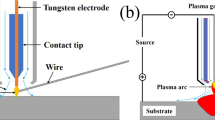Abstract
The Plasmare melting process employs a highly stable, direct current, transferred arc emanating from a non-consumable electrode to melt and process metals and alloys. The rate of power delivery and the point of application of arc heat are under the complete control of the process user. Operation of the Plasmare in an argon atmosphere results in a clean uncontaminated source of heat, permitting precise control over metal bath chemistry. Preliminary evaluation of AISI 4340, A-286, Rene 41, and 17-4 PH alloys has shown that the metal is of superior quality with physical properties equal to vacuum-melted material.
Similar content being viewed by others
Bibliography
Quality Requirements of Super-Duty Steels, Metallurgical Society Conferences, vol. 3, May 5-6, 1958, Pittsburgh, Pa.
E. C. Nelson: Factors Governing the Extent of Deoxidation of Iron-Carbon Alloys by Argon Rinsing. Presented at Annual Meeting, AIME, Feb. 1962.
Serge Cvikevich: Mechanical Properties of AISI 4340 Improved by Consumable-Electrode Vacuum Remelting, Watertown Arsenal Laboratories Technical Report No. WAL TR 310, 1/1, Sept. 1959.
P. S. Schaffer: Theoretical and Practical Aspects of Vacuum-Induction Melting of High Strength Steels, Watertown Arsenal Report No. RPL 10/17, Mar. 1960.
J. Chipman: Atomic Interaction in Molten Alloy Steels, Iron & Steel Institute Journal, vol. 180, June 1955, pp. 97–106.
R. D. Pehlke and J. F. Elliot: Solubility of Nitrogen in Liquid Iron Alloys, 1. Thermodynamics, Trans. AIME, vol. 218, December 1960, pp. 1088–1101.
M. Weinstein and J. F. Elliott: Solubility of Hydrogen in Liquid Iron Alloys, Presented at the Annual Meeting of AIME, Feb. 1962.
M. Ohtani and N. A. Gokcen: Thermodynamic Interaction Parameters of Elements in Liquid Iron, Trans. AIME, vol. 218, June 1960, p. 533–540.
Carbon Oxygen Equilibrium
T. Fuwa and J. Chipman: The Carbon-Oxygen Equilibria in Liquid Iron, Trans. AIME, vol. 218, Oct. 1960, p. 887–891.
J. Chipman and T. C. M. Pillay: Activities in Dilute Liquid Solution Fe-Si-O, Trans. AIME, vol. 221, Dec. 1961, pp. 1277–1278.
J. Chipman and D. Dutilloy: Activity of Oxygen in Liquid Iron-Phosphorus Alloys, Trans. AIME, vol. 218, June 1960, pp. 428–430.
J. Chipman and J. F. Elliott: Physical Chemistry of Liquid Steel, Chapter 16 of Electric Furnace Steelmaking, (In press).
General Background
A Summary of Comparative Properties of Air-Melted and Vacuum-Melted Steels and Superalloys. DMIC Report 128, Mar. 28, 1960.
H. R. Larson and F. B. Herlihy: Development of Low Alloy Steel Components Suitable for High Strength Steel Castings, Trans, of American Foundryman’s Society, vol. 67, 1959, pp. 718–731.
S. Z. Uram, M. C. Flemings, and H. F. Taylor: High Strength Cast Steel Structure and Microporosity Effect on Mechanical Prop High Strength Cast Steel Structure and Microporosity Effect on Mechanical Properties, Modern Castings, vol. 38, July 1960, pp. 61–74.
M. C. Flemings, R. V. Barone, S. Z. Uram, and H. F. Taylor: Solidification of Steel Castings and Ingots, Modern Castings, vol. 40, Sept. 1961, pp. 82–95.
H. J Henning and F. W. Boulger: High Strength Steel Forgings, DMIC Report 143, January 5, 1961.
J. I. Fisher and J. P. Sheehan: The Effect of Metallurgical Variables on the Fatigue Properties of AISI 4340 Steel Heat Treated in the Tensile Strength Range 260,000–310,000 psi, WADC Technical Report 58–289, Feb. 1959.
H. J. Hucek, A. R. Elsea, and A. M. Hall: Evolution of Ultra-high-Strength, Hardenable Steels for Solid Propellant Rocket-Motor Cases, DMIC Report 154, May 25, 1961.
W. E. Schwabe: Experimental Results with Hollow Electrodes in Electric Steel Furnaces, Iron and Steel Engineer, vol. 34, June 1957, pp. 84–91.
Author information
Authors and Affiliations
Rights and permissions
About this article
Cite this article
McCullough, R.J. Plasmarc Furnace, A New Concept in Melting Metals. JOM 14, 907–911 (1962). https://doi.org/10.1007/BF03378203
Published:
Issue Date:
DOI: https://doi.org/10.1007/BF03378203




